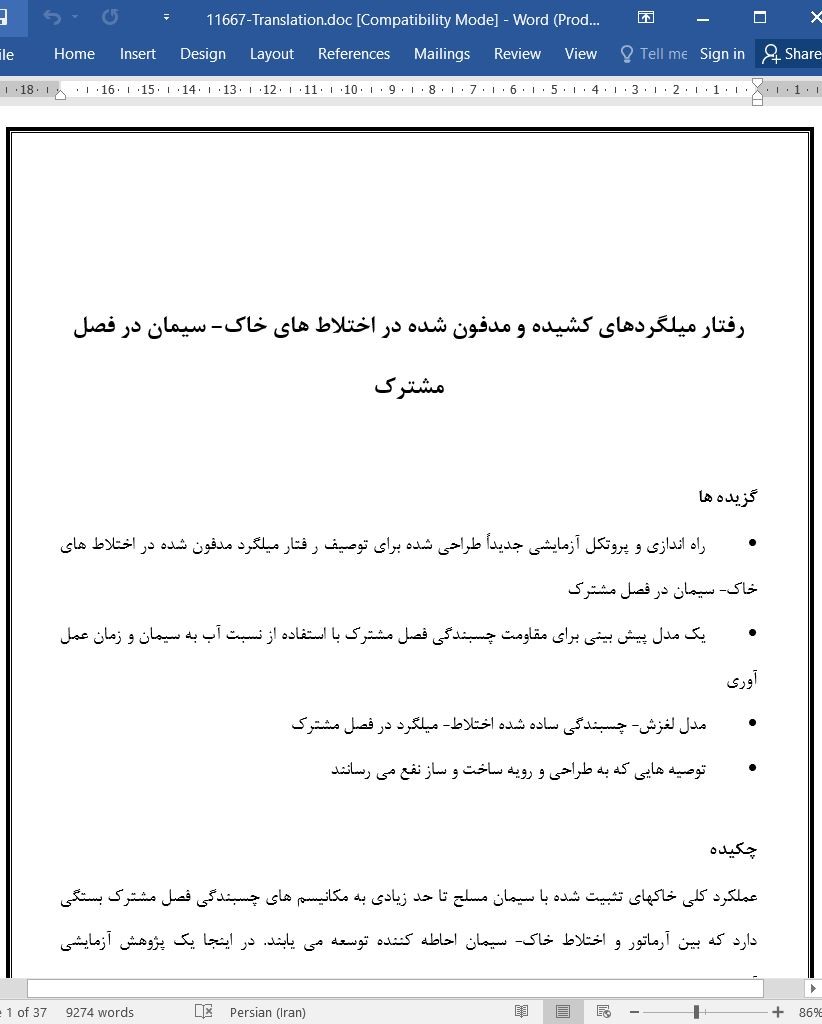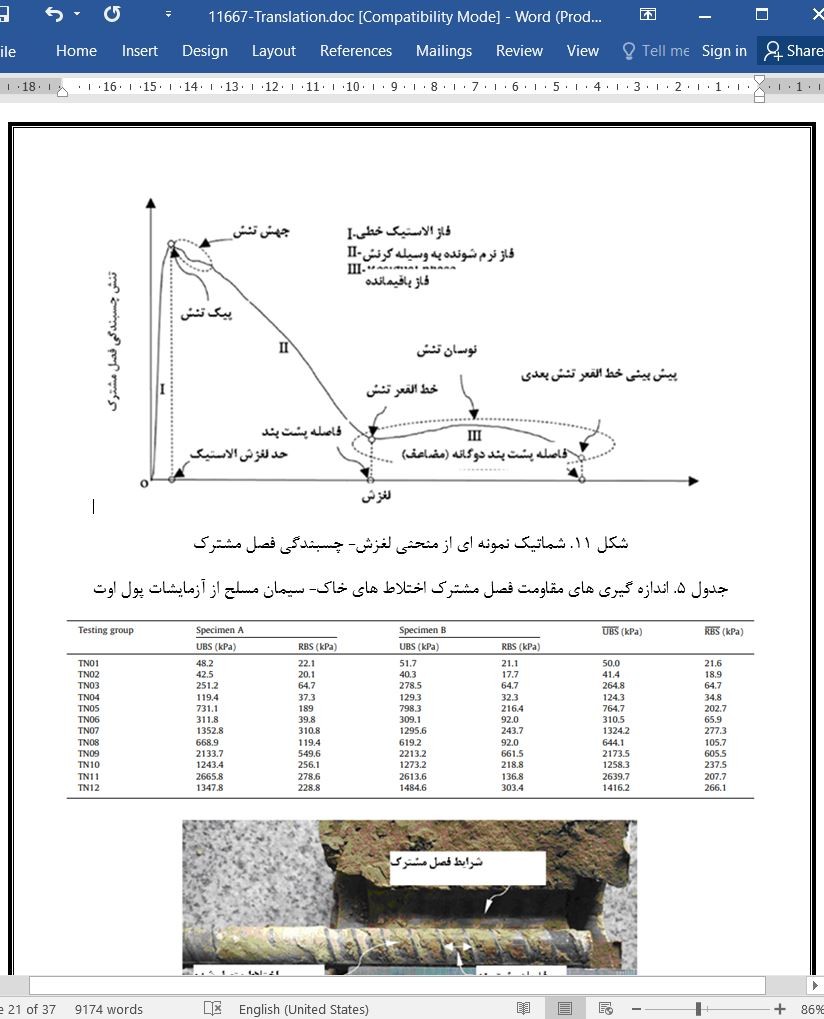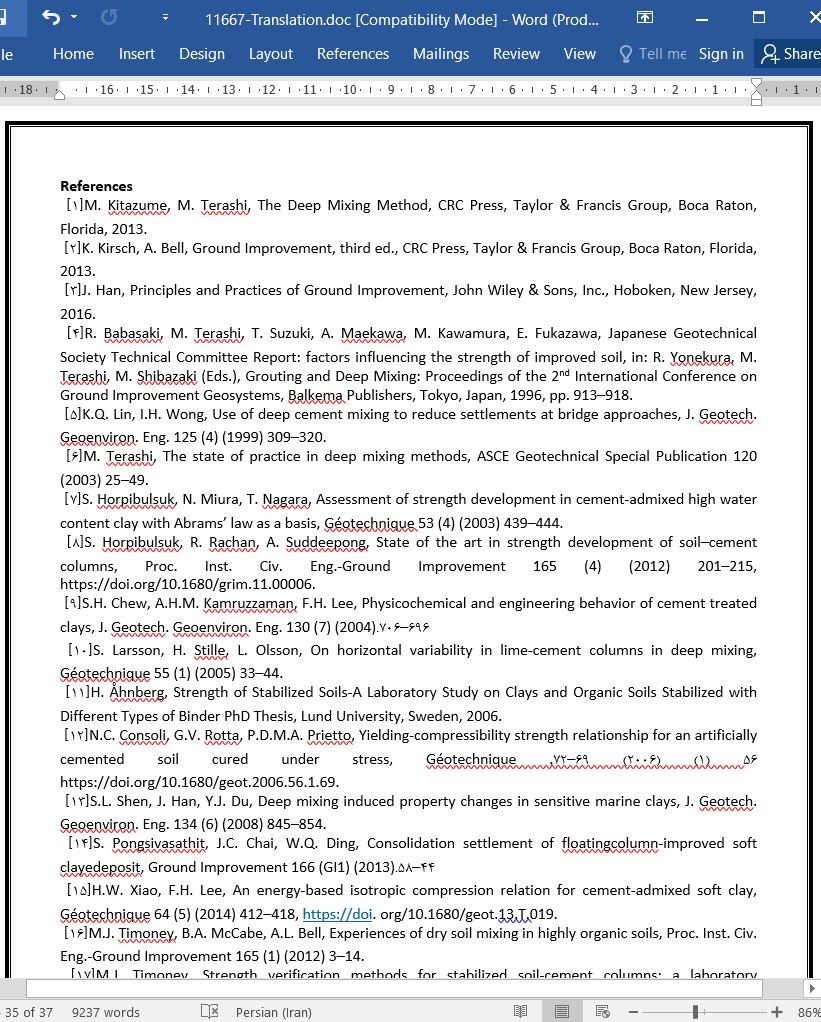
رفتار میلگردهای کشیده و مدفون شده در اختلاط های خاک- سیمان در فصل مشترک
چکیده
عملکرد کلی خاکهای تثبیت شده با سیمان مسلح تا حد زیادی به مکانیسم های چسبندگی فصل مشترک بستگی دارد که بین آرماتور و اختلاط خاک- سیمان احاطه کننده توسعه می یابند. در اینجا یک پژوهش آزمایشی آزمایشگاهی مبتنی بر نظریه طراحی یکنواخت برای توصیف رفتار فصل مشترک میلگردهای تابیده مدفون شده در خاکهای مخلوط شده با سیمان انجام شد. مطالعه حاضر بر تاثیر میزان سیمان، میزان آب و مدت عمل آوری (کیورینگ) بر پاسخ فصل مشترک تاکید نمود. مقاومت چسبندگی فصل مشترک اختلاط خاک- سیمان مسلح ، که در آزمایشات (تستهای) پول اوت اندازه گیری شده، متناسب با مقاومت اختلاط خاک- سیمان است که از آزمایشات فشاری تک محوره بدست آمد. در بخشی از این مطالعه، یک مدل لغزش- چسبندگی سه خطی ساده شده توسعه یافت که در هنگام درجه بندی درست، می توانست پاسخ برشی فصل مشترک اختلاط- میلگرد را توصیف نماید. در این راستا همبستگی هایی بدست آمد که بین مقاومت چسبندگی فصل مشترک با سه عامل تاثیرگذار بررسی شده در این مطالعه، ارتباط برقرار می کنند. روندهای بدست آمده در مورد تاثیر هر عامل بر مقاومت چسبندگی فصل مشترک، بینش هایی مناسب برای راهنمایی طراحی فعلی و رویه ساخت اختلاط خاک- سیمان مسلح فراهم نمود. نتایج و پروتکل های مطرح شده در این مطالعه، درک مکانیسم برشی فصل مشترک بین میلگرد تابیده و اختلاط خاک- سیمان را تسهیل نموده و انتظار می رود ابزارهای کافی برای تامین فقدان فعلی پارامترهای چسبندگی فصل مشترک اختلاط- میلگرد در خصوصیات طراحی سازه های اختلاط خاک مسلح فراهم نمایند.
1. مقدمه
در مهندسی ژئوتکنیک سیمان به عنوان یکی از مهمترین چسب ها/ اختلاط ها برای بهسازی زمین وتثبیت آن به ویژه در رس ها و لجن نرم یا آلوده شده، شناخته شده است [1، 2]. با استفاده از تکنیک های اختلاط خاک و جت گروتینگ (تزریق با فشار بسیار بالا)،سیمان یا دوغاب را می توان به درون منافذ خاکهای ضعیف تزریق کرد که این کار موجب واکنش های پوزولانی و تشکیل اختلاط های خاک- سیمان با ویژگیهای بهبودیافته می شود [3]. مطالعات تحقیقاتی پژوهشی زیادی برای بررسی خصوصیات مکانیکی و هیدرولیکی بهبودیافته خاکهای تثبیت شده با سیمان، از جمله افزایش مقاومت و استحکام، کاهش تراوایی و نفوذپذیری، و کاهش تراکم پذیری انجام شده است [4-18].
Abstract
The overall performance of reinforced cement-stabilized soils depends significantly on the interface bond mechanisms that develop between the reinforcement and the surrounding cement-soil mixture. A laboratory experimental investigation based on uniform design theory was carried out to characterize the interface behavior of deformed bars embedded in cement-admixed soils. The study focused on the influence of cement content, water content and curing duration on the interface response. The interface bond strength of reinforced cement-soil mixture, as measured in pullout tests, was found to be proportional to the strength of cement-soil matrix, as obtained from unconfined compression tests. A simplified trilinear bond-slip model was developed as part of this study, which when properly calibrated was found to be capable of characterizing the bar-mixture interface shear response. Correlations were obtained to relate the interface bond strength with the three influence factors investigated in this study. The trends obtained on the influence of each factor on the interface bond resistance provided insights that were suitable to guide current design and construction practice of reinforced cement-soil mixture. The results and testing protocols presented in this study facilitated the understanding for interface shear mechanism between deformed bar and cement-soil mixture, and are expected to provide adequate means to satisfy the current lack of bar-mixture interface bond parameters in design specification for reinforced soil mixing structures.
1. Introduction
Cement has been recognized as one of the most important binders/admixtures in geotechnical engineering for ground improvement and stabilization, especially in soft or contaminated clays and sludge [1,2]. Using techniques of soil mixing and jet grouting, cement or slurry can be introduced into the pores of naturally weak soils resulting in pozzolanic reactions forming soil-cement mixtures of improved characteristics [3]. Many research studies were conducted to investigate the improved mechanical and hydraulic properties of cement-stabilized soils, such as strength increase, permeability decrease, and compressibility reduction [4–18].
گزیده ها
چکیده
1. مقدمه
2. برنامه آزمایشی
3. خصوصیات مواد
4. آماده سازی نمونه
5. روش آزمایش
6. نتایج آزمایش
7. آنالیزهای رگرسیون برروی نتایج آزمایش
1. 7. مقاومت چسبندگی نهایی فصل مشترک در برابر مقاومت فشاری تک محوره
2. 7. مقاومت چسبندگی باقیمانده فصل مشترک (RBS) در برابر مقاومت چسبندگی نهایی فصل مشترک
3. 7. مقاومت چسبندگی نهایی فصل مشترک به عنوان تابعی از عوامل تاثیرگذار
4. 7. مدل ساده شده چسبندگی- لغزش فصل مشترک
8. بحث
9. نتایج
منابع
Abstract
1. Introduction
2. Testing program
3. Material properties
4. Specimen preparation
5. Testing procedure
6. Experimental results
7. Regression analyses on test results
7.1. Ultimate interface bond strength (UBS) versus unconfined compressive strength (UCS)
7.2. Residual interface bond strength (RBS) versus ultimate interface bond strength (UBS)
7.3. Ultimate interface bond strength as a function of influence factors
7.4. Simplified interface bond-slip model
8. Discussions
9. Conclusions
References
- اصل مقاله انگلیسی با فرمت ورد (word) با قابلیت ویرایش
- ترجمه فارسی مقاله با فرمت ورد (word) با قابلیت ویرایش، بدون آرم سایت ای ترجمه
- ترجمه فارسی مقاله با فرمت pdf، بدون آرم سایت ای ترجمه



